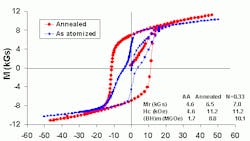Breakthrough in Magnet Research May Yield Better Motors For Electric Cars
Researchers at the U.S. Department of Energy's (DoE) Ames Laboratory have designed a high-performance permanent magnet alloy that operates with good magnetic strength at 200ºC. This capability could make it possible to build electric drive motors—the type required in electric vehicles and hybrid electric vehicles—that are more efficient and cost-effective. Depending on market demand for hybrid vehicles, the alloy powder could become commercially available within a few years. At that point, the powder could quickly be used to fabricate better magnets and permanent magnet motors for cars.
The alloy was developed by Iver Anderson, an Ames Lab senior metallurgist and Iowa State University adjunct professor of materials science and engineering, in conjunction with his Ames Lab colleagues Bill McCallum and Matthew Kramer. Their work was done as part of the DOE's Vehicle Technologies Program to develop more energy-efficient and environmentally friendly highway transportation technologies that will enable America to use less petroleum.
Anderson explains that future ultragreen vehicles will include fully electric cars, fuel-cell automobiles and plug-in hybrids. "They all have electric drive motors, so that's a common theme," he said. "It's important that those motors be made economically with an operating envelope that fits how they will be driven. The automotive companies in this country have set out a series of parameters that they would like electric motors to meet."
One of those constraints being addressed by Anderson and his colleagues is the need for permanent-magnet electric motors to operate well at temperatures up to 200ºC. "That raised a lot of eyebrows for people who know anything about magnets," says Anderson. He explains that the most desirable permanent-magnet materials are neodymium-iron-boron magnet materials based on a 2-14-1 crystal structure – Nd2Fe14B.
"Most of those types of magnets tend to lose a lot of their magnetic energy at fairly modest temperatures and are operating at much less than half of their power by the time they reach 100ºC to 125ºC," says Anderson. "So our challenge was to design a high-performance 2-14-1 permanent magnet alloy that would operate with good magnetic strength at 200ºC."
Meeting that challenge, Anderson, McCallum and Kramer designed an alloy that replaces pure neodymium with a mixed rare earth. "We used a combination of neodymium, yttrium and dysprosium because they all form 2-14-1 crystal structures," says Anderson. "Together they have much less degradation of their magnetic properties with temperature due to the influence of the yttrium and dysprosium. Our concept, put forth in our patent application, is that the mixed rare earth 2-14-1 phase would have a lower temperature coefficient."
Once they had optimized the new alloy, the researchers processed it into a fine, spherical powder form using gas atomization. That’s a technique in which kinetic energy from supersonic jets of gas is transferred to a stream of liquid metal, causing it to break up into droplets. A hysteresis loop for a powder sample is shown in the figure.
"This method best fits the needs of the automobile industry because they want to make their motors by a very high-volume manufacturing process, and that method is injection molding," explained Anderson.
"Currently, each magnet making up the magnet array in an electric motor is glued in by hand. That's fine for small runs of 50,000 automobiles, but try doing that for the millions of cars with electric drive motors – one for the front and one for the back – that consumers will want to buy in the next 10 years," says Anderson. "It's not going to work."
Anderson and his colleagues have been refining and pushing the 2-14-1 alloy composition to be more suitable for the rapid solidification that happens in the atomized powder droplets and ultimately for the injection-molding process. "We've succeeded in getting very nice properties for these fine spherical powders," says Anderson. He notes that in comparing their powders to spherical commercial powders of larger size, he and his colleagues look at the "crossover in temperature" at which the properties of their magnet powders become better than the commercial powders for higher temperature uses. "It used to be 175ºC," says Anderson, "but now we've moved that crossover temperature down to the neighborhood of 75ºC, which is a tremendous accomplishment – we're very happy about that."
Anderson says they now have what they think is a really good alloy, and also have switched from helium gas to argon gas in the atomization process, which makes the powder-making process a lot cheaper. "That's a move in the right direction for the purposes of commercialization," he says.
The timeframe for commercializing the alloy technology is not long, but depends on market factors. “If demand for hybrids is high, then we’ll see commercialization of the alloy powder within two to three years, “says Anderson. From there, the development of magnets and permanent magnet motors based on the alloy is fairly straightforward explains Anderson. He notes that there are already existing motor designs that could use the new magnets.
Reflecting on the goals of the Vehicle Technologies Program, Anderson said, "We need to support our auto companies and help them develop better products. We can do that by getting things worked out at the basic science end – that's our job."
Anderson added, "You can think of this alloy design work as the fundamental end of extending the temperature range of 2-14-1 magnet alloys. Then, we're also working on the process end, which is a fundamental rapid solidification effort to develop the solidified microstructure that will carry the best magnetic properties over in a form that can be mass-produced. You can call this 'use-inspired' research, for sure."
